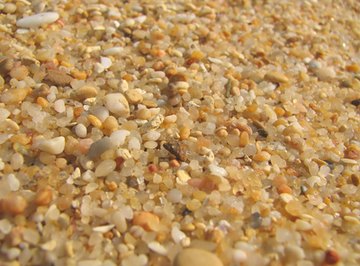
Silicon makes up 25.7 percent of the Earth's crust, by weight, and is exceeded in abundance only by oxygen. Silicon occurs principally in a family of silicate minerals and in sand. Silica is a common name for silicon dioxide, the principal material in sand. Silica is a chemical compound of silicon that contains the element oxygen. The weight percentage of silicon in silica can be calculated if you know the relative masses of silicon and oxygen.
Use the procedure to find the weight-percentage of silicon in hydrated forms of silica, know as silicic acid. For example, SiO2.2H20 has two water molecules bonded to each SiO2. The molecular mass of water (18) must be included in the calculation: 28.055/ (28 + 32 + (18 x 2)) = 0.29. Multiply this number by 100 to arrive at the answer: SiO2.2H20 is 29.2 percent silicon by weight. The Periodic Table is an important scientific tool, a chart of the known chemical elements organized by atomic number (the number of protons in the nucleus of each atom) and atomic mass (the total of protons and neutrons). By scientific convention, the masses of elements are represented as atomic mass units, defined relative to carbon (C) which is arbitrarily assigned mass 12.000.
Find the atomic masses of silicon (symbol Si) and oxygen (symbol O). You can find them in the Periodic Table Of The Elements (See Resources.) Si appears near the top of the table on the right half of row 3. O appears above Si in row 2.
Determine the molecular mass of silica by adding together the atomic masses of all the elements in a molecule of silica. Silica has the formula SiO2, which in chemical terms means that each molecule is composed of one silicon atom bonded to two oxygen atoms. Your calculation should then be: 28.0855 (Si) + (15.9994 (O) x 2) = 60.084.
Calculate the weight-percentage of silicon in silica by dividing the atomic mass of silicon by the molecular mass of silica: Your calculation should be: 28.055/60.084 = 0.4669. Multiply this number by 100 to convert it to percent. Your final answer is: silica contains 46.69 percent silicon by weight.
Tips
References
About the Author
A Toronto native, Michael Merry began writing on health and fitness in 2010. He contributes to LIVESTRONG.COM, eHow, and Answerbag.com. Merry has an extensive background in chemical and metallurgical research, physics, nuclear radiation analysis, and associated technologies. He is an avid amateur astronomer, accomplished chess player, and a health and fitness enthusiast. Michael holds a Bachelor of Technology from Ryerson University.
Photo Credits
beach sand close-up background image by kubais from Fotolia.com
